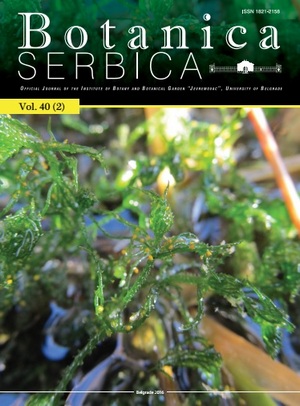
Volume 40 Issue 2 2016 |
Editorial
|
| |
Professor Dr. Jelena Blažencic,
On the occasion of her 80th birthday
|
| |
Dominance of Microcystis spp. in Lake Dojran – a consequence of 30 years of accelerated eutrophication
|
KEY WORDS: Lake Dojran, eutrophication, phytoplankton changes, Microcystis sp. dominance, neo-tropical form |
Qualitative and quantitative composition of the algal
community in the water column of the Grlište reservoir
(Eastern Serbia)
|
KEY WORDS: algae, species diversity, biomass, seasonal succession, abundance |
Macrophytic vegetation in the oligotrophic Mediterranean Lake Vrana
(Island of Cres, Northern Adriatic) – New insight after 50 years
|
KEY WORDS: charophytes, macrophytes, helophytes, karst lake, stratification, Croatia |
Macrophyte vegetation as a structuring factor of the
macrozoobenthic communities in Lake Ohrid
|
KEY WORDS: Lake Ohrid, macrophyte vegetation, macrozoobenthos, habitats |
Epilithic diatom flora from sub-Mediterranean
intermittent rivers in Bulgaria during two hydrological
periods
|
KEY WORDS: Bacillariophyta, Mediterranean rivers, phytobenthos, river type R14 |
First record of the genus Decussata (Patrick) LangeBertalot (Bacillariophyta) in Serbia – distribution of
the rare species D. hexagona (Torka) Lange-Bertalot
|
KEY WORDS: Bacillariophyta, Decussata hexagona, distribution, autecology, Vrla River, Rasina River |
Revision of the Stauroneis smithii Grunow
(Bacillariophyceae) species complex from Macedonia
|
KEY WORDS: diatoms, Macedonia, new species, Stauroneis blazenciciae, Stauroneis smithii complex |
Prestauroneis blazenciciae, a seventh species of the genus proposed as new to science
|
KEY WORDS: saline springs, Prestauroneis, Navicula, Prestauroneis blazenciciae |
The charophyte fossil record on the Iberian Peninsula: a synthesis
|
KEY WORDS: Charophyta, Spain, Portugal, Mesozoic, Cenozoic |
Chara vulgaris L. (Charales) in springs
on Amorgos island (Greece)
|
KEY WORDS: Greece, Amorgos, springs, Chara vulgaris f. longibracteata |
The charophyte flora in a Ramsar Mediterranean
wetland (Albufera de València Natural Park, Spain)
during the period 2007-2010
|
KEY WORDS: Albufera de València Natural Park, Characeae, species richness, anthropogenic disturbances, rice fields, springs, interdunal ponds |
Species of Nitella (Charophyceae, Charales) from Israel:
low species richness and rare occurrence
|
KEY WORDS: charophytes, Characeae, Nitella, species richness, ecology, species protection, Eastern Mediterranean |
New finds of Chara oedophylla Feldmann in Tunisia:
signifcance of sejoined gametangia
|
Here we provide an emended diagnosis that highlights the differences compared to C. vulgaris in order to maintain C. oedophylla as a valid species. The significance of sejoined gametangia with respect to speciation is discussed. KEY WORDS: Characeae, temporary habitat, North Africa, monoecism, dioecism |
Contribution to knowledge of the charophytes
(Charales) of Vojvodina (Serbia) – 20 years afer the
frst review
|
KEY WORDS: charophytes, richness, distribution, habitat |
Diversity of macromycetes in the Botanical Garden
“Jevremovac” in Belgrade |
KEY WORDS: Botanical Garden “Jevremovac”, diversity, macromycetes |
First record of the rust fungus Endophyllum sempervivi (Alb. & Schwein.) de Bary (Pucciniomycetes) in Serbia
|
KEY WORDS: houseleek, pathogen, rust basidiomycete, Serbia |
Bookreviews
|
Ninkovic Slavica Radojevic, Lj. 2016. Biotechnology in Horticulture. Trees I. – Belgrade: AGM knjiga, Institute for Biological Research “Siniša Stankovic”. 259 pp.; hardcover. ISBN 978-86-86363-65-7 (AGMK). [Radojevic, Lj. 2016. Biotehnologija u hortikulturi: Drvece 1. – Beograd: AGM knjiga, Institut za biološka istraživanja “Siniša Stankovic”. 259 str.] (In Serbian) Stevanovic Vladimir Strid A. 2016. Atlas of the Aegean Flora. Part 1: Text & Plates, 700 pp. Part 2: Maps, 878 pp. – Englera 33 (part 1 & 2). Berlin: Botanic Garden and Botanical Museum Berlin, Freie Universität Berlin. Hardcover. ISBN 978-3- 921800-97-3 (part 1); 978-3-921800-98-0 (part 2). Price: EUR 120 (both parts together) (In English) KEY WORDS: |
RETRACTION: |


